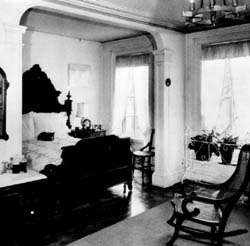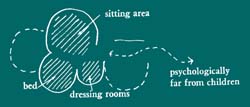



Every couple start out sharing each other's adult lives. When children come, concern for parenthood often overwhelms the private sharing, and everything becomes exclusively oriented toward the children.
In most houses this is aggravated by the physical design of the environment. Specifically:
1. Children are able to run everywhere in the house, and therefore tend to dominate all of it. No rooms are private.
2. The bathroom is often placed so that adults must walk past children's bedrooms to reach it.
3. The walls of the master bedroom are usually too thin to afford much acoustical privacy.
The result is that the private life of the couple is continually interrupted by the awareness that the children are nearby. Their role as parents rather than as a couple permeates all aspects of their private relations.
On the other hand, of course, they do not want to be completely separated from the children's rooms. They also, want to be close to them, especially while the children are young. A mother wants to run quickly to the bed of an infant in an emergency.
These problems can only be solved if there is a part of the house, which we call the couple's realm; that is, a world in which the intimacy of the man and woman, their joys and sorrows, can be shared and lived through. It is a place not only insulated from the children's world, but also complete in itself, a world, a domain. In many respects it is a version of the pattern HOUSE FOR A COUPLE (77), embedded in the larger house with children.
The couple's realm needs to be the kind of place that one might sit in and talk privately, perhaps with its own entrance to the outdoors, to a balcony. It is a sitting room, a place for privacy, a place for projects; the bed is part of it, but tucked away into an alcove with its own window; a fireplace is wonderful; and it needs some kind of a double door, an ante-room, to protect its privacy.
